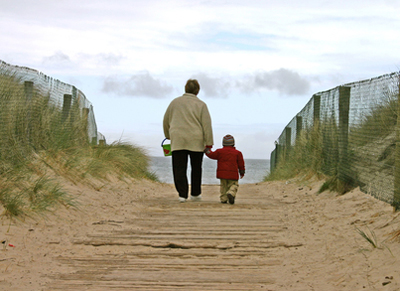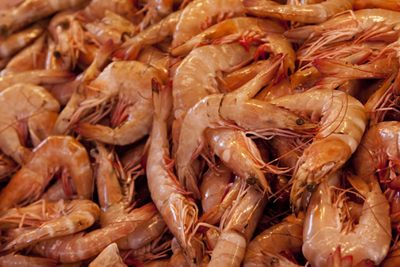How to go shrimping
Nick Fisher explains the pleasure of shrimping


I once caught a mighty blue marlin in the Pacific, just north of New Zealand. I've also caught a huge bronze whaler shark in the sea south of Cape Town, and, in Cuba, I landed a barracuda roughly the size of a well-nourished sixth-former. But none of these enormous trophy fish brought me any-
where near the sheer unbridled pleasure that I experienced last summer, catching three dozen brown shrimps off a beach in north Norfolk.
Apart from the satisfaction quota, shrimping with a push net along the Norfolk shore is, in many ways, much more skilful than fishing for marlin. It's about man pitting his wits and guile against the formidable forces of nature. It's all about unravelling the mysteries of tides, winds and weather. It's about the hunt for prey, the fight, the capture and, finally, the feast.
This was the sport that P. G. Wodehouse's Jeeves exercised his mind with while on holiday. Shrimping has all the glory and reward that the primal hunter-gatherer seeks-and, best of all, it only takes place in ankle-deep water. At its best, shrimping is the perfect mixture of childish pleasures and adult pursuits. It's play blended with business. It's the joy of paddling married with the serious stuff of putting a meal on the table. For those of you who have yet to enjoy the toe-curling pleasure of the activity, let me explain the basics.

Method
Shrimping is performed at low tide on a flat sandy or muddy beach with a push-net, which is, quite simply, a miniature version of a beam-trawler, but in reverse. Instead of dragging a beam and a net-as in trawling-you're pushing a beam or blade (of wood or steel) that's angled in a precise way to cut down into the sand or mud a couple of inches deep.
The net's blade, ideally 2ft-3ft wide, acts like a shallow plough or harrow, in that it turns over the underwater surface of the beach. The net needs to be pushed along, disturbing the beach bed under the cover of water, because shrimps need at least 6in in order to be able to swim around, feed and burrow under the sand.
Sign up for the Country Life Newsletter
Exquisite houses, the beauty of Nature, and how to get the most from your life, straight to your inbox.
The shrimps (and prawns, crabs and various small fish) feel the vibrations of something heading towards them, ploughing up the seabed, and they make a run for it. They eject themselves from the sand and are enveloped in the net that's behind the digging blade. Push-netting works best if you're pushing into waves or current because water movement propels the shrimps in the right direction-into the net.
Most experienced shrimpers push their nets along parallel to the shore a few yards out in the water between calf and thigh deep. Serious shrimpers will push their huge nets (I've seen custom-made ones 6ft wide) in all seasons.
The autumn months can be good for shrimps, even though the water is cold. In these hardy conditions, the serious shrimper wears thigh or chest waders, or even a diver's dry suit. Much as I admire these well-equipped hunter-gathers in their quest for Crangon crangon, the elusive but delicious crustacean, I'm more of a fair-weather shrimper myself. I only want to go shrimping with the sun on my back and the promise of garlic mayonnaise on my lips.
Location is all-important, but not as important as timing. You can take yourself to the very best shrimping beach in Britain, but if you're there at the wrong state of the tide, you stand more chance of getting a bulge in your mesh pushing your shrimp net around a supermarket car park.
What you want is low tide, the lower the better. A spring low tide (which occurs around every full moon) is the lowest low tide. Depending on your beach of choice, this can be the best time of all. Don't just fish at low tide, but at least an hour either side of low water. Tide tables (available from local tackle stores) have a year's worth of tide times, local papers publish the week's tide times and phone apps such as Tides Planner will provide you with decades' worth of intricate tidal movements.
On some beaches, when the tide is out, little lagoons and ‘rivers' are exposed once the sea has retreated. As well as pushing your net along the sea-covered beach a few yards out, parallel to the shore, it's worth pushing your net through any lagoons, no matter how small. Sometimes, these can be shrimp sanctuaries, where they hole up in between tides and where the canny netsman has the opportunity to bag up beautifully without ever setting foot in the sea proper.
The kit
Apart from the alluring promise of potted shrimp for tea, what I love about the activity is the simpli-city of the kit. Once you have a net and a bucket, you're sorted. There's no bait required, no hooks, no line, no tricky knots, no casting, no reeling, no hooking and zero risk of seasickness- shrimping is more like foraging than fishing. The action itself feels more like mowing a very large garden with an ancient lawnmower, but instead of a basket full of new-mown grass, the prize is salty, succulent crustaceans.
The risks
The weever fish is a small, sharp-spined fish that inhabits shallow, warm, sandy, coastal bays and has a sting as sharp as a hornet, delivered with a thud, like a kick from a naughty pony. In my experience of many summers on the sand, weever fish are rare. I've never actually caught one in a net, only when rod-and-line fishing, and I've never stood on one either.
Sensible people wear plimsolls or waterproof beach shoes while messing about in the shallows. I always intend to, but never quite remember.
A wiser man than I would always wear foot protection of some sort. Once you have net, bucket and suitable footwear, the next requirements are a beach and a tide table.
I would be risking a slapped wrist from the Health and Safety Executive if I didn't warn about two very important things-incoming tide and weather forecasts. If the beach you've chosen has lagoons and creeks, be very aware of the incoming tide. It's easy to get cut off with water squeezing up through creeks behind you.
Start off with easy, short beaches, preferably in summer when there are lots of people and even lifeguards on duty. Always carry a mobile phone.Never tackle any big beach alone and always check weather forecasts. If they forecast wind increasing or incoming fog, stay at home and bake bread and cheese scones instead.

The results
To me, shrimping is best when it's just another element in a day at the beach-like taking the dog for a swim, collecting seashells or burying my youngest son up to his nostrils in sand. After a 50-yard push through the shallows (which can feel like proper exercise), to return to the sand and sort through a haul is fun for all the family.
Apart from hopefully finding a few shrimps that try to flip and twitch their way back to sea, there are little crabs, sand eels, tiny flat fish, all manner of wonderful weeds, cockles, clams and critters.
Some days, I'll even take the portable gas ring or the bucket barbie and boil our haul of shrimps and a couple of dozen mussels, freshly picked from the breakwater for a salty snack before the sun sets.
Believe me, I've eaten tuna steaks and sipped ice-cold sundowner mojitos on Caribbean beaches that haven't been half as much fun, or tasted half as good.
* Subscribe to Country Life and save; Get the Ipad edition
* Follow Country Life magazine on Twitter
Country Life is unlike any other magazine: the only glossy weekly on the newsstand and the only magazine that has been guest-edited by HRH The King not once, but twice. It is a celebration of modern rural life and all its diverse joys and pleasures — that was first published in Queen Victoria's Diamond Jubilee year. Our eclectic mixture of witty and informative content — from the most up-to-date property news and commentary and a coveted glimpse inside some of the UK's best houses and gardens, to gardening, the arts and interior design, written by experts in their field — still cannot be found in print or online, anywhere else.
-
 The King's favourite tea, conclave and spring flowers: Country Life Quiz of the Day, April 22, 2025
The King's favourite tea, conclave and spring flowers: Country Life Quiz of the Day, April 22, 2025Tuesday's Quiz of the Day blows smoke, tells the time and more.
By Toby Keel
-
 London is the place for me* (*the discerning property buyer)
London is the place for me* (*the discerning property buyer)With more buyers looking at London than anywhere else, is the 'race for space' finally over?
By Annabel Dixon